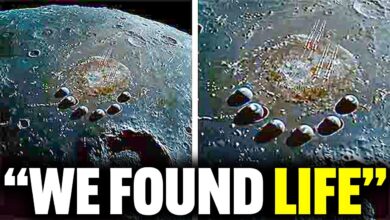SHOCKING Footage Caught by Drone Near American Coast!

On the morning of September 16, 2023, without warning, the Earth began to emit a deep, strange sound, causing the entire Earth’s crust to vibrate. Seismic warning devices around the world detected these tremors that lasted for 9 days. Scientists were puzzled, while a terrible disaster was taking place in Greenland. Although it was not an earthquake, they realized that it was a phenomenon they had never seen before. The signal had a unique frequency, like a steady pulse from underground.
After many days of research, an international team of scientists from 15 countries discovered that the cause was water. A massive landslide occurred in a remote part of Greenland, causing a mountain nearly 4,000 feet high to collapse into the water below. The massive amount of debris that fell into the sea created a 360-foot tsunami that was trapped in the canyon and caused a shock wave powerful enough to register on seismometers around the world.
The event also made scientists more alert to natural disasters, as they realized that nearly 40% of the United States was at risk of landslides. Some areas in California such as Rancho Palos Verdes are affected by unstable geology, with rapidly shifting soil causing cracks and severe damage to homes. Residents are forced to live without electricity and water in harsh conditions.
Meanwhile, Arizona also recorded signs of underground volcanic activity, although the volcanoes in the area are currently dormant. This is a reminder of the potential danger and the need to prepare for natural disasters that can strike at any time.
At the bottom of the ocean, there exists a unique and vast ecosystem of microorganisms that scientists have recently discovered. This ecosystem is located in the cracks of basalt rock, and the creatures here do not need sunlight but rely on chemical reactions between the rock and seawater. Scientists call it a “chemosynthetic ecosystem” – life that is sustained by chemical reactions instead of light. Although this form of life has been found in hydrothermal vents and deep underground mines, its scale under the ocean crust is enormous, possibly the largest ecosystem on Earth.
Since the 1990s, scientists have discovered tiny pores in basalt that appear to be created by bacteria, despite the extremely harsh environment there and the lack of organic compounds. In the years since, they have discovered that energy-rich compounds are concentrated in the central part of the oceanic crust, supporting the existence of microorganisms, but as they move closer to the crust’s edge, these compounds are depleted. Current research shows that bacteria here use hydrogen as an energy source, converting carbon dioxide into organic matter and producing methane and other compounds, creating a web of life.
This discovery not only helps us better understand the forms of life that can survive in extreme conditions, but also opens up new research directions for the possibility of life on other planets. NASA is also investing in deep-sea research to search for clues about the oceans of exoplanets, and to test equipment for future missions.
Exploring the deep ocean remains challenging due to the extreme pressures, cold temperatures and lack of light. To do this, scientists use many modern technologies such as satellites that monitor the color of the ocean to determine the amount of plankton, or autonomous diving devices to collect data. These efforts have brought significant results such as the discovery of deep coral reefs and new species, helping to preserve and protect marine ecosystems.

Although the ocean covers more than 80% of the Earth’s surface, there are still many unexplored areas, and only about 7% are protected as marine reserves. These studies provide the basis for establishing new reserves, and encourage scientists to continue exploring to expand our understanding of our planet.
A thin layer of oil, when placed on the surface of water, creates a film just one molecule thick, acting as a barrier to prevent the wind from creating waves. Scientist Benjamin Franklin once used this method to calm the surface of a lake, making him look like a “water magician” when he just lightly touched the lake with an oil-filled stick. Today, this technique is used to produce anti-glare glass for electronic devices.
Geographically, the Earth is an ellipse and not a perfect sphere, with the North and South Poles being slightly flattened due to the planet’s rotation. Interestingly, gravity is not uniform across the globe. For example, heavy mountain regions exert a stronger gravitational force than deep ocean trenches. At the bottom of the Indian Ocean, there is a “gravity pit” where gravity is weaker than normal. Scientists believe this phenomenon is the result of “magma flows” from the Earth’s mantle, creating a region of lower density.
Additionally, Earth’s geological activity creates powerful magma flows, leading to the formation of underwater volcanoes. A major underwater volcanic eruption near Madagascar created a volcano that rose more than 8,500 feet above the sea floor. Earth’s tectonic plates also pull seawater into the deep mantle, helping to form magma and potentially trigger earthquakes. The movement of water and minerals through the Earth’s crust also creates stunning underwater landscapes, from underground lakes and rivers to mountain ranges and canyons.
Although most volcanic activity occurs under the sea, scientists are still studying ancient geological formations, such as pieces of oceanic crust pushed into the mantle hundreds of miles deep. Diamonds from these deep layers help scientists better understand the structure and composition of the planet’s interior.
The debate over whether a new ocean exists, bordering the Atlantic, Pacific, and Indian Oceans, remains unresolved among scientists, who note that each ocean features unique marine life adapted to specific conditions. For instance, the Southern Ocean is home to species like leopard seals, orcas, and emperor penguins, as well as krill, essential to the marine food chain.
Life on Earth is believed to have begun approximately 3.5 billion years ago, potentially in ocean depths. Recently discovered microscopic tubes and filaments within ancient oceanic crust suggest early life forms thrived in hydrothermal vent conditions. Scientists are also puzzled by various mysterious ocean sounds, such as the “upsweep,” a changing signal first recorded in 1991, likely linked to undersea volcanic activity.
Another sound, known as the “bloop,” was recorded in 1997, characterized by its immense volume, likely created by icebergs fracturing. Other strange sounds, like the “whistle” and “Julia,” have been linked to ice movements and large icebergs. The “52 Hertz whale,” a unique and solitary call, has yet to be traced back to its source.
In North Carolina, mysterious sounds called “seneca guns” have been reported for over 150 years, attributed to various theories, including atmospheric phenomena and meteors. Similar “skyquakes” occur globally, often near large bodies of water, with various potential explanations, including shifting sand dunes and volcanic eruptions.
The “Bristol hum,” first reported in the 1970s, perplexed residents but was later linked to ocean wave vibrations. In New Mexico, the “Taos hum,” heard by only a fraction of residents, has no identified source.
Exploration of the ocean’s depths remains limited; the Mariana Trench, the deepest known part of the ocean, was first studied in 1875 and reached in 2012. Phantom bottoms, misleading sonar signals indicating nonexistent seafloors, have also been discovered, resulting from swarms of jellyfish and other deep-sea creatures rising to feed at night. Overall, our understanding of underwater life and phenomena is still developing, highlighting the vast mysteries of the ocean.
Archaeologists recently discovered a 7,000-year-old road off the southern coast of Croatia, beneath layers of sea mud at the ancient Neolithic site of Soine, which was once a human-made island. The site was protected from strong waves, allowing for its preservation. Meanwhile, scientists have identified over 30 potential new species at the bottom of the Pacific Ocean, collected via remote-controlled vehicles, including unique invertebrates and segmented worms.
Additionally, traces of rare plutonium and iron found in the Pacific likely originated from cosmic events and could help scientists understand how elements heavier than iron are formed.
In a hypothetical scenario, if all the Earth’s volcanoes erupted simultaneously, the results would be catastrophic, blocking sunlight with ash and causing acid rain. Although such an event is unlikely due to the independent magma sources of each volcano, ongoing volcanic activity is observed, such as in British Columbia and Antarctica, where researchers discovered over 130 volcanoes beneath the ice, with some still active.
Supervolcanoes like Yellowstone present the greatest eruption threats, having the potential for massive impacts on the environment and climate. While monitoring continues, Yellowstone has had only three major eruptions in the past 2.1 million years, and current conditions do not indicate an imminent eruption.








